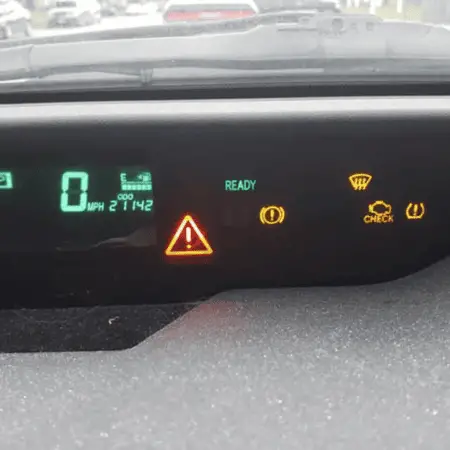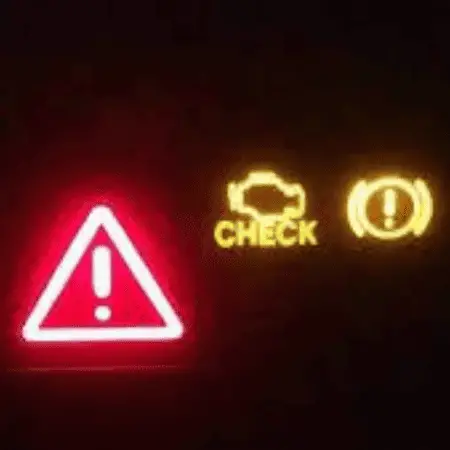Have you ever noticed a small light on your dashboard that looks like a little triangle with an exclamation mark inside it? That’s called the master warning light. It’s like a little messenger that tries to tell you something important about your car. In this article, I will guide you on “how to turn off the master warning light”. So keep on reading…
How to turn off the master warning light? Turning off the master warning light in your car isn’t as simple as flicking a switch. When the master warning light comes on, it’s because your car’s computer has detected a problem that needs attention. To turn off the light, you’ll need to address the issue causing it to come on in the first place. This might involve checking your engine oil, coolant levels, or other vital parts of your car. Once you’ve fixed the problem, the master warning light should go off on its own. If it doesn’t, you might need to have a mechanic take a look to make sure everything’s okay.

My Recommendations
- Complete Car Repair Tool Kit
- OBD-II Scanner for Car Diagnostics
- Engine Oil – High Performance
- Roadside Emergency Kit
Why does the master warning light come on?
The master warning light comes on to alert you when something isn’t right with your car. It’s like a signal from your car’s brain telling you that there might be a problem that needs fixing. This light can come on for various reasons, like low oil pressure, engine overheating, or problems with your brakes. When the master warning light flashes, it’s essential to pay attention and take action to keep yourself and your car safe.
Safety Precautions When the Master Warning Light is On
When the master warning light comes on in your car, it’s a sign that something needs your attention. Safety precautions are necessary to ensure your safety and the proper functioning of your vehicle. These steps may help you in this situation.
Stay Calm and Aware: The first and most important thing to do is to stay calm and aware of your surroundings. Panicking won’t help, but staying focused will allow you to address the issue effectively.
Reduce Speed and Pull Over: If you’re driving when the master warning light comes on, reduce your speed and safely pull over to the side of the road or into a parking lot. Driving with the warning light on could potentially worsen the problem or lead to an unsafe situation.
Check Your Owner’s Manual: Consult your car’s owner’s manual to understand what the master warning light is indicating. It will provide valuable information about the potential issues and what actions you should take.
Assess the Situation: Once safely stopped, assess the situation. Look for any obvious signs of trouble, such as smoke, strange noises, or unusual smells. However, avoid opening the hood immediately, especially if you’re unsure about handling car components.
Call for Assistance: If you’re unable to identify or address the problem yourself, it’s best to call for assistance. This could mean contacting a roadside assistance service, a trusted mechanic, or someone who can help you diagnose and fix the issue.
Do Not Ignore the Warning Light: Whatever you do, do not ignore the master warning light. Even if your car seems to be running fine, there could still be an underlying issue that needs attention. Ignoring the warning light could lead to more significant problems later on.
Do Not Attempt Repairs Unless Trained: Unless you’re a trained mechanic or have experience working on cars, avoid attempting any repairs yourself. Trying to fix the problem without proper knowledge could result in further damage or even injury.
Stay Safe While Waiting: While waiting for assistance to arrive or while assessing the situation, make sure to stay safe. Keep your hazard lights on, and if possible, use reflective triangles or flares to alert other drivers to your presence, especially if you’re stopped on a busy road.
Follow Up After Repairs: Once the issue causing the master warning light to come on has been addressed and repaired, it’s a good idea to follow up. Make sure the warning light goes off as it should, and if not, consult a professional to ensure everything is in proper working order.
By following these safety precautions when the master warning light is on, you can help ensure your safety and the continued reliable operation of your vehicle.

how to turn off the master warning light
Turning off the master warning light in your car can be a bit tricky because it’s not like turning off a regular light switch. Here’s a simple explanation of how to do it:
1- Fix the Problem: The first thing you need to do is figure out why the master warning light came on in the first place. Check things like your engine oil, and coolant level, or if any other warning lights are on. Once you find the problem, try to fix it.
2- Fixing the Problem: If the issue is something simple like low tire pressure, you can fill up your tires at a gas station. If it’s something more serious like an engine problem, you might need to take your car to a mechanic to get it fixed.
3- Wait for it to Go Off: After you’ve fixed the problem, you might need to wait a bit for the master warning light to go off on its own. Sometimes, it takes a little time for the car’s computer to realize that the problem has been fixed.
4- Resetting the Light: In some cars, you can manually reset the master warning light using buttons on your dashboard. You can check your car’s manual or look online to see if there’s a specific way to do it for your car.
5- Consult a Mechanic: If you can’t figure out how to turn off the master warning light or if it doesn’t go off even after you’ve fixed the problem, it’s a good idea to take your car to a mechanic. They can help you figure out what’s going on and make sure everything is okay.
Can you reset the master warning light yourself?
Yes, in some cases, you can reset the master warning light yourself. However, it depends on the make and model of your car and the specific issue that triggered the warning light. Some vehicles have a reset button or a sequence of steps you can follow to reset the warning light after you’ve solved the problem.
To reset the master warning light yourself, you typically need to:
- Ensure the issue that triggered the warning light is resolved. This might involve fixing low tire pressure, replenishing engine oil, or addressing other mechanical problems.
- Locate the reset button or follow the specific reset procedure outlined in your car’s manual. This could involve pressing and holding a combination of buttons on your dashboard for a certain amount of time.
- Follow the reset procedure carefully. It may take a few seconds or minutes for the reset process to complete.
- Once the reset is successful, the master warning light should turn off.
Must read
- Why Red Light Blinking In Car And What To Do
- How To Clear Service Suspension System? Explained
- How To Remove Too Much Transmission Fluid?
- Should I Wax My Car After Every Wash? Explained
Conclusion
To turn off the master warning light in your car, you should first address the problem that caused it to come on. Once you’ve fixed the issue, wait for a bit to see if the light goes off on its own. If it doesn’t, you may be able to reset it yourself using the reset button or following specific steps outlined in your car’s manual. If you’re unsure or if the light stays on even after fixing the problem, it’s best to consult with a mechanic for assistance. Remember, it’s important to never ignore the master warning light and to always address any underlying issues promptly to ensure your safety on the road.
